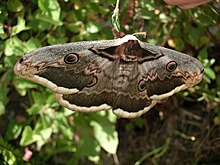Saturnia pyri, the giant peacock moth, great peacock moth, giant emperor moth or Viennese emperor, is a Saturniid moth which is native to Europe. The species was first described by Michael Denis and Ignaz Schiffermüller in 1775. It is the largest European moth, with a wingspan reaching 15–20 cm (6–8 in).
| Giant peacock moth | |
|---|---|

| |
| Scientific classification | |
| Domain: | Eukaryota |
| Kingdom: | Animalia |
| Phylum: | Arthropoda |
| Class: | Insecta |
| Order: | Lepidoptera |
| Family: | Saturniidae |
| Genus: | Saturnia |
| Species: | S. pyri
|
| Binomial name | |
| Saturnia pyri (Denis & Schiffermüller, 1775)
| |
| Synonyms | |
| |
The giant peacock moth has a range that includes the Iberian Peninsula, southern France, northern Hungary, central and southern Serbia, Croatia, Montenegro, southern and eastern Bulgaria, southern Greece southern Turkey, south Kyrgyzstan, western Syria, Lebanon, north Israel, southern Romania, Russia, Ukraine, Czech Republic, Slovak Republic, Slovenia, North Macedonia and Italy and extends into Siberia and north Africa. It is absent from the UK, though a small handful of individuals have been recorded, likely of captive origin.[1]
Additional images
edit-
Hatching, with the egg still attached - on an almond leaf
-
Caterpillar
-
Caterpillar - high resolution
-
Caterpillar - detail
-
Cocoon
-
Male - MHNT
-
Female
-
On a hand showing its large size
-
In the Czech Republic
-
In Greece
-
On Mount Meron in northern Israel
References
edit- ^ "Hants Moths". Retrieved 15 September 2014.